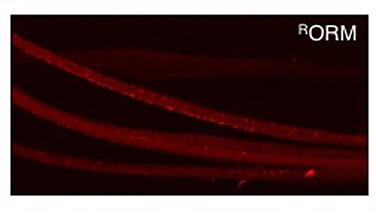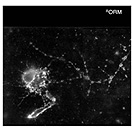News
'ORMOSIL' nanoparticles hold
promise for drug delivery

The bright red spots in this confocal microscopy image are clusters of ORMOSIL particles in axons of fruit fly neurons. Photo: COURTESY OF SHERMALI GUNAWARDENA AND PLOS ONE
-
 Print
Print -
 Comments
Comments
-

A neuron in primary neuronal cultures generated from a brain of a fruit fly is aglow with ORMOSIL. Photo: COURTESY OF SHERMALI GUNAWARD
Click here to watch videos showing both a normal axonal pathway and a blocked pathway.
In the images of fruit flies, clusters of neurons are all lit up, forming a brightly glowing network of highways within the brain.
It’s exactly what UB researcher Shermali Gunawardena was hoping to see: It meant that ORMOSIL, a novel class of nanoparticles, had successfully penetrated the insects’ brains. And even after long-term exposure, the cells and the flies themselves remained unharmed.
The particles, which are tagged with fluorescent proteins, hold promise as a potential vehicle for drug delivery.
Each particle is a vessel, containing cavities that scientists potentially could fill with helpful chemical compounds or gene therapies to send to different parts of the human body. Gunawardena is particularly interested in using ORMOSIL—organically modified silica—to target problems within neurons that may be related to neurodegenerative disorders, including Alzheimer’s disease.
The recent study on fruit flies is a step toward making this happen, demonstrating that long-term exposure to ORMOSIL, through breathing and feeding, did not injure the animals.
The research appeared in the journal PLoS ONE on Jan. 3.
“We saw that after feeding these nanoparticles in the fruit fly larvae, the ORMOSIL was going mainly into the guts and skin. But over time, in adult flies, you could see it in the brain. These results are really fascinating because these particles do not show any toxic effects on the whole organism or the neuronal cells,” says Gunawardena, assistant professor of biological sciences and a researcher in UB’s Institute for Lasers, Photonics and Biophotonics.
The ORMOSIL particles she is investigating are a unique variety crafted by a research group led by Paras N. Prasad, the institute’s executive director. Each particle contains cavities that can hold drugs that can be released when the particles are exposed to light.
Besides Gunawardena and Prasad, co-authors on the study include Farda Barandeh, Phuong-Lan Nguyen, Rajiv Kumar, Gary J. Iacobucci, Michelle L. Kuznicki, Andrew Kosterman and Earl J. Bergey, all from UB.
Gunawardena is an expert in axonal transport, which involves movement of motor proteins along neurons’ thread-like axon. These molecular motors, called kinesins and dyneins, carry “cargo,” including vital proteins, to and from the synapse and cell body of neurons.
In this neuronal highway system, one problem that can occur is an axonal blockage, which resembles a traffic jam in neurons. Proteins aggregate in a clump along the axon.
Researchers don’t know whether these obstructions contribute to disorders such as Alzheimer’s or Parkinson’s diseases, which are characterized by unusual build-ups of proteins called amyloids and Lewy bodies.
But the amyloid precursor protein involved in Alzheimer’s disease has been shown to have a role in axonal transport and if axonal obstructions do turn out to be an early indicator for neurodegeneration seen in Alzheimer’s disease, eliminating blockages could help prevent or delay the onset of disease.
That’s where ORMOSIL comes in: Gunawardena hopes to use these nanoparticles to target drugs to protein jams along axons, breaking up the accumulations.
Success, if possible, is still a long way off. But the potential benefit is great. Gunawardena calls the research a “high-risk, high-rewards” endeavor.
The next step is for her team to see if they can find a way to force the ORMOSIL to latch onto motor proteins since the nanoparticles, on their own, do not move along axons.

Reader Comments